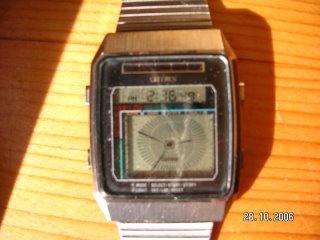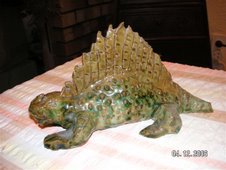I'd like to introduce you to what for me is a kind of good luck charm. No, I'm not overly superstitious, and maybe I should have rephrased that, to stress that the good luck was all in the past. What you see at the left is perhaps better described as a "a feel-good artefact" - a more accurate, if less endearing kind of description. The story of this watch, and how it has come to acquire its talismanic status, will be the subject of today's and tomorrow's posts. It's my Citizen watch, photographed in harsh sunlight on the mezzanine stairs two days ago. But the sunlight was needed to highlight a key feature of this very unusual time-piece. Look carefully at the hands (click on the photo to enlarge if necessary). You will see that they are not continuous. There is a break that corresponds with a faint circle in the background. It's because this is no ordinary watch, with solid metal hands, and thus with moving parts to drive those hands. It's a rare form of digital watch in which the hands are simulated on the LCD display. By photographing in unflattering sunlight, you can see in shadowy form all 60 of the radial stop positions needed for a complete sweep by the second and minute hands.
The sunlight also shows up another feature, a coloured border that starts at green, in dim light, then extends further into a red zone in brighter light, and which in the picture has reached the blue zone, under the small numeric display. The book of words that came with the watch described it as a "light meter", as if it were an essential aid to survival in modern life. I suppose it could be handy for photographers, but is, I suspect, just a gimmicky feature, albeit an attractive one, that adds life and colour to the watch face. In a practical sense it also shows that the clever photocell is working - the one that keeps the battery topped up, extending its lifetime enormously.
There's another mode I hesitate to mention, but it amused the children enormously when they were small. Press a button and the watch emits a clear and quite tuneful continuous note. If one then covers or partially covers the light cell, the pitch of the note changes, depending on the reduced light. With practice, one can get a tune simply by moving one's hand !
I haven't told you how old this watch is yet. You may be surprised. It was bought in 1984, when I was briefly flush with funds, having done a little private tutoring on the side. Yes, it had its 22nd birthday this year. It's been worn almost continuously, except for 6 months with a Accurist watch - a birthday present- that was a pain, needing to be reset each time a 30 day month changed to a 31, or 28, or vice-versa, and then finally gave up the ghost. I couldn't bother putting it in for repair, being more than happy to go back to Old Faithful. The latter has had just 3 replacement batteries in its life. On the second occasion it was sent back to Citizen for a new watch face, following an intense spell of abrasive DIY,and came back with some little faults on the mode shift buttons fixed, without my having requested them, all for a fairly nominal extra charge. But I've been doing some research, and suspect that Old Faithful may have brought tears to the eyes of some old-timers in Citizen's service section. You see, it appears that I own something that now has rarity value, although I have yet to confirm that on eBay. I only discovered this recently when I did the round of the shops, looking for a replacement with a similar simulated hands display. I could not find one. So I went to the Internet, and still could not.
After diligent searching, I finally located a site, URL since mislaid, sad to say, that mentioned my watch, and gave a clue as to why it's no longer available. It's to do with the way that watches are manufactured according to a basic design and then launched in a range of styles - a bit like cars in a way. Apparently the "chassis design" so to speak of the simulated hand watch means they cannot ring the changes where other features are concerned. That would explain why there was just my Old Faithful as the sole representative of its type in the jeweller's shop window all those years ago. But I have an eye for the unusual, so did not mind shelling out the £35
back in the early 80s. What would that be at current prices ? Not a lot, certainly not into the bling category, but neither a "wear for 6 months, then throwaway" item either.
When I look at the watch, I not only see one of the best purchases of my entire life. I think of the young woman whom I tutored successfully for O-Level maths. That allowed her to clear the last obstacle that had been standing in the way of a coveted place at music college, as well as putting a little extra cash in my pocket. I also think of the reasons why I allowed the agency (Personal Tutors) to coerce me into tutoring in something that was not my main subject, but how tutoring was to be a life-saver when the cold winds of Thatcherism began to blow in the late 80s, finally ending my career as a research scientist.
Tomorrow's post will have an intimidating-looking graphic - a mathematical equation, probably one that few people have seen, outside of the mortgage industry. It's a formula I worked out for myself, in 1967, one year out of University, when wondering how they figured out the fixed monthly payment on a repayment mortgage. I did it with nothing more than, guess what, O-Level maths. Oh yes, and SBP (sheer bloody persistence).
Some might call it being "obsessed".
I was wondering when we'd hear from you, hippo.
Maybe, but here's something to think about. Yesterday's Sunday Times got it wrong on carbon monoxide - said it was denser than air, formed a layer at ground level (see my post below). Maybe they will publish a correction next Sunday, or a small letter tucked away in geeks' corner, if someone bothers to put pen to paper. Chances are they won't, and will continue on their way regardless, continuing to litter the world with their careless factual inaccuracies. I'm quite unforgiving where the Sunday's are concerned. They have had days on the Corfu story to check and re-check their facts, especially in something headed "Carbon Monoxide: the Facts".
A scientist could not get away with this kind of sloppiness. Any factual errors in their work would get picked up, sooner or later, and then be passed baton-like from one published paper to the next, which is science's way of ridding itself of unhelpful and misleading contributions. Can you blame scientists for being eagle-eyed, obsessional even, when it comes to the facts ? It's a trait that is essential to their professional survival, and that once acquired, is difficult to shake off. Is this why scientists are given such wide berth in the MSM - becuase we science bods find it hard to conceal our disdain for careless or indifferent reporting of the so-called facts.
pm: sent the following email to The Editor, Sunday Times:
Under "Carbon monoxide: the facts" (ST, October 29, Focus) it is stated that CO is "a heavy gas that builds from the floor up". Not so. CO is slightly less dense than air. Maybe there's been some confusion with carbon dioxide. Precise figures, for those that are interested, can be found on my blog (see post for Oct 29).
http://www.dreams-and-daemons.blogspot.com/
Yours faithfully
Colin Berry







No comments:
Post a Comment